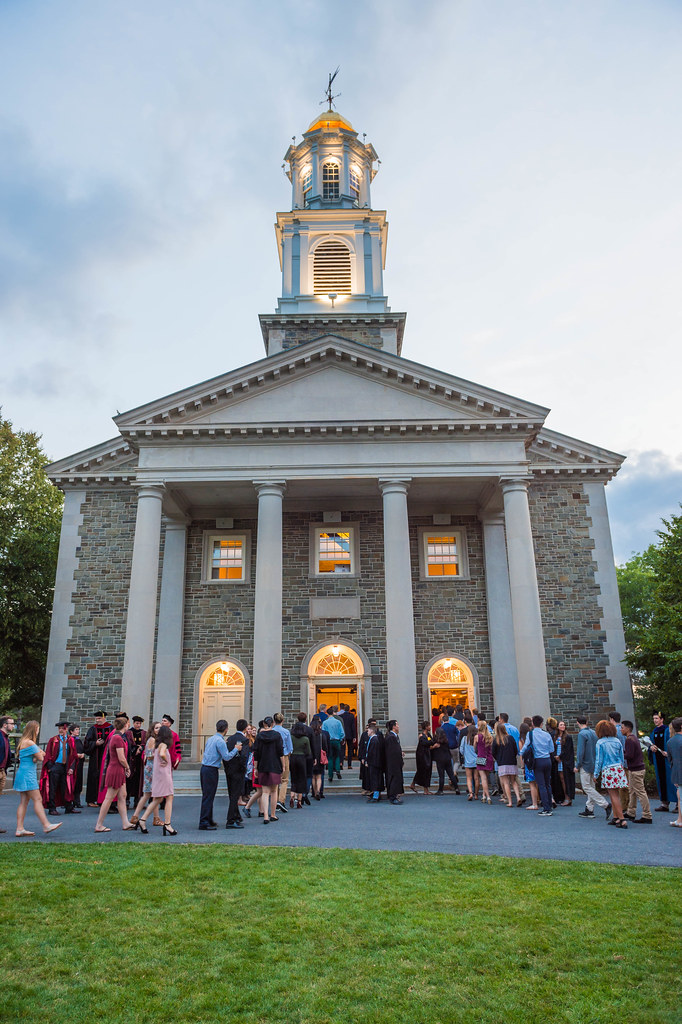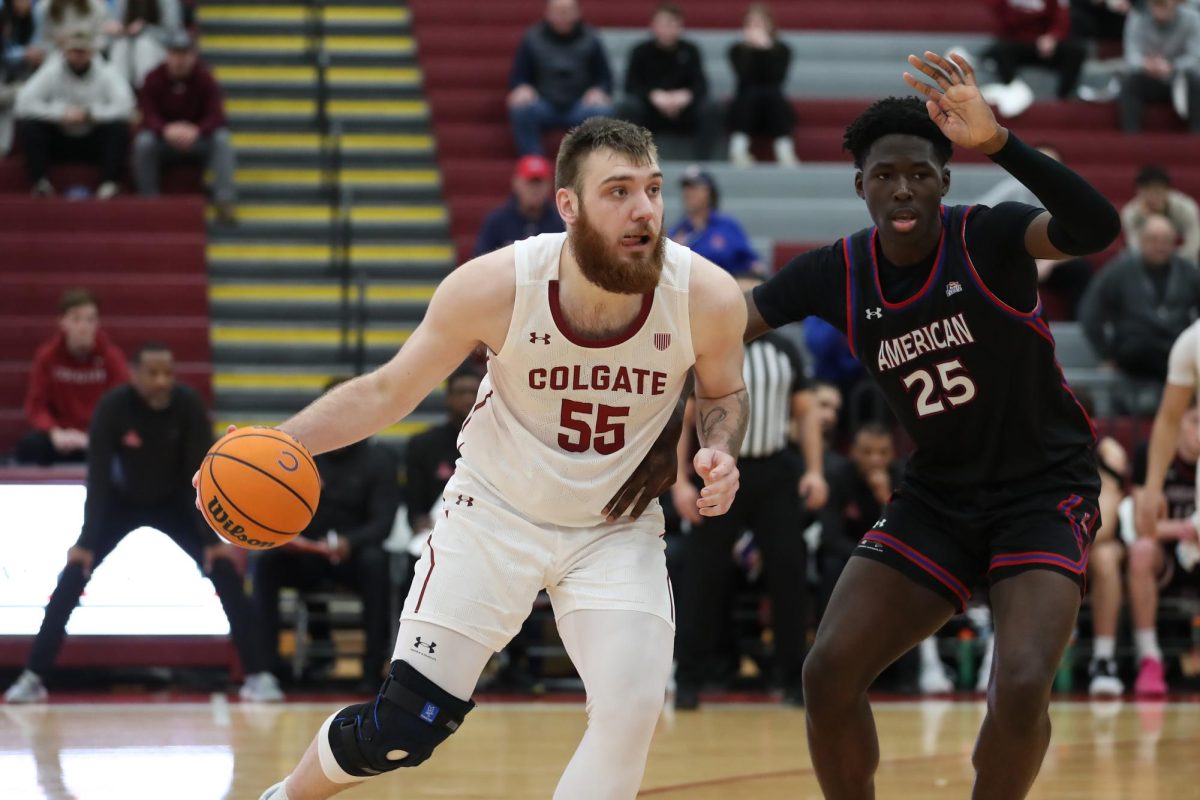A cornerstone of Colgate University’s campus, the Colgate Memorial Chapel sits atop the hill at the heart of the main academic quad. Its iconic golden dome, a hallmark of university imagery, graces promotional materials and remains instantly recognizable to students and alumni alike. Originally built in the early 1900s, the chapel’s symmetrical design has stood as a defining landmark of Colgate’s campus for over a century.
The chapel has a rich history, with the plans of its construction first mentioned in 1914 during a Colgate Board of Trustees meeting. Mary Colgate funded the project in memory of her father — giving the Colgate Memorial Chapel its name. At the time, only about half of the current academic quad existed, consisting of West Hall, East Hall, Lathrop Hall, Alumni Hall and what is now Olin Hall. The chapel’s placement would prove pivotal in shaping future campus expansion, solidifying its role as the centerpiece of Colgate’s landscape.
While the chapel’s exterior is symmetrical and uniform — featuring a rectangular footprint and nearly identical north and south sides, each lined with six columns of windows that allow natural light to pour in, its true essence lies within. Inside, the space serves as a gathering place for a wide range of groups, fostering the community and connection that makes Colgate so special. The space is versatile, and from hosting Dancefest to guest speakers, it is not just the chapel’s location that places it at the heart of campus.
Though it is a multi-use space, the chapel also serves as the hub for religious life on campus. Despite its original design as a Baptist church, it now welcomes a diverse range of faiths, hosting weekly gatherings for groups such as the Colgate Newman Community, the Muslim Student Association, Hindu Student Association and the University Church. It stands as a unifying space for spiritual reflection and community, embracing all traditions. Reverend Corey MacPherson shared what it means to have this shared space for religious practice.
“As the Protestant Chaplain, I see the chapel as a vibrant, multi-use space. We regularly host interfaith services, community gatherings, and smaller group meetings in the chapel basement. On any given day, whether it’s a formal religious service, a brown bag discussion or a guest lecture, the chapel is abuzz with activity.” MacPherson explained. “The chapel functions as the heart of spiritual and community life on campus.”
The history of the building continues to have a deep impact on its use, and continues to impact the culture and legacy of Colgate today.
“The chapel’s history is deeply impactful — it’s housed in a building with historic New England church architecture, yet it intentionally lacks permanent religious symbols.” MacPherson stated. “This design choice reflects our mission to create an interfaith space that welcomes students from all religious and secular traditions. This blend of historical character with modern, inclusive functionality is what makes the chapel such a special and enduring part of our campus community.”
Among the groups who use the chapel for secular purposes, the Colgate Thirteen are some of the more frequent occupiers. The Thirteen are an a cappella group on campus, and have performed on iconic stages from the US Embassy in Beijing to Lambeau Field. The Thirteen travel frequently, but they also perform at the chapel for major occasions, such as parents’ weekend and their senior concert, events that may seem less prestigious but carry emotional significance and tradition. This year, the Thirteen is also performing their senior jamboree on Saturday, April 5, in the chapel, with almost entirely new material.
Bo Koebler, a sophomore and second-year member of the Thirteen, shared that no matter how far they travel, the chapel will always be the stage that feels like home.
“Standing under the bright stage light in front of a packed crowd is nothing short of sublime. There’s a giddiness about that stage, and a kind of reverence it brings out in us. You can hardly see the audience, and you’re so focused on the music and your fellow musicians up there that everything else falls away, and it’s you all and the music and nothing else,” Koebler explained.
In the midst of a performance, there is a moment where time seems to slow, when both the musician and the audience are almost suspended in time. This moment, referred to as the gap, is an especially unique moment within the chapel.
“And then comes the most incredible thing — a moment every musician knows: the gap. A song ends, and the last reverberations of our voices ring. Everything holds still for a beat, suspended in midair, and the audience erupts in raucous applause,” Koebler said.
Sophomore Jordan Quimby, a bass and vocal percussionist for the Colgate Resolutions, another Colgate a cappella group, described the unique acoustic environment of the chapel.
“The stage feels electric and enhances our voices in a way that makes harmonies richer and more resonant,” Quimby explained. “The space itself also adds a level of connection with the audience that we don’t always get in other venues. There’s something meaningful about sharing music with people who are part of the same community, whether it’s friends, professors or classmates who might be hearing us for the first time.”
The chapel is also home to Colgate’s University Orchestra, where students and professional musicians perform two concerts per semester. The orchestra uses the chapel as a performance and practice space, allowing the building to host a community of musicians as they progress together.
Sophomore Alyssa Bleyl has been performing with the orchestra for almost two years, after playing violin for nearly ten. Bleyl particularly appreciates the orchestra concerts, as a culmination of their rehearsal and preparation.
“The chapel is a beautiful space for performances, and I think the acoustics really bring out all of the instruments’ sounds. It’s always rewarding to finally share everything we’ve been working on with the audience and see how they respond to the music,” Bleyl said.
The Colgate Memorial Chapel is undeniably a campus icon. Whether it’s the ringing of its bells or the way its golden dome catches the sunlight, the chapel remains an ever-present part of daily life for students and faculty alike.

















